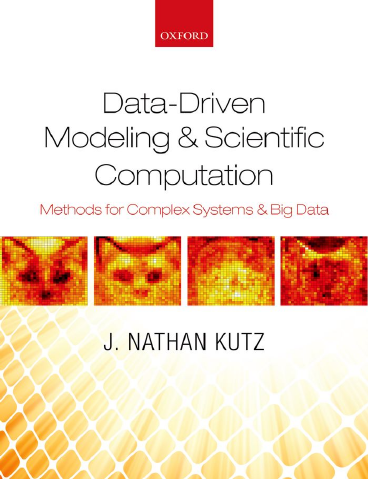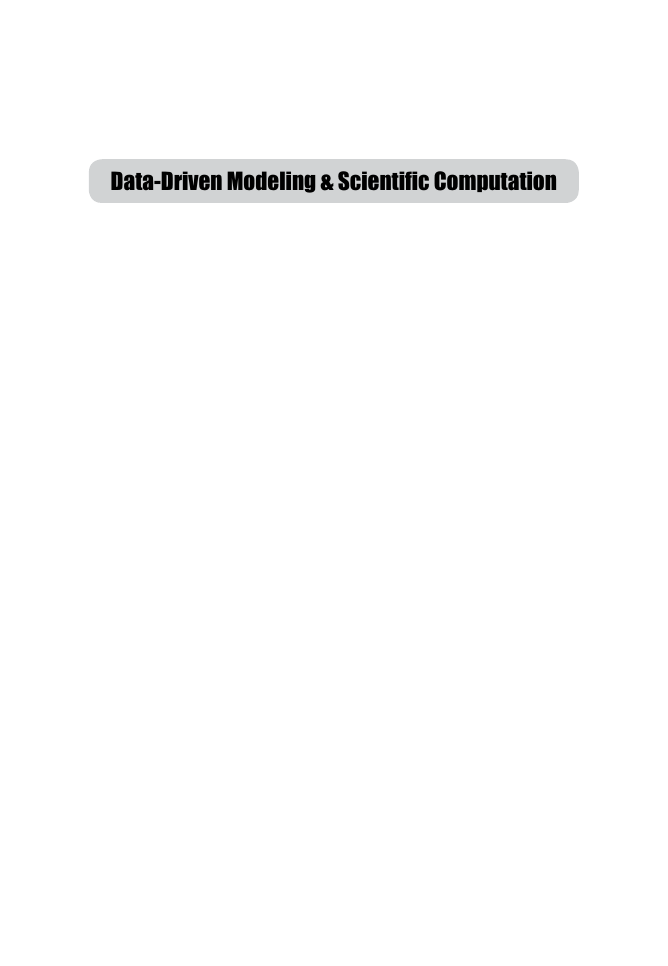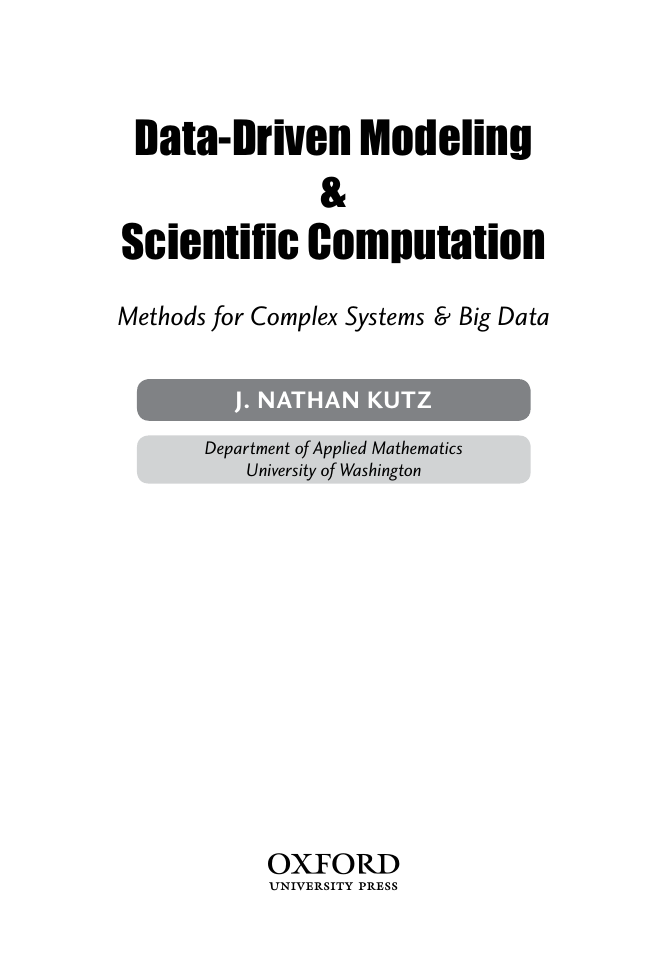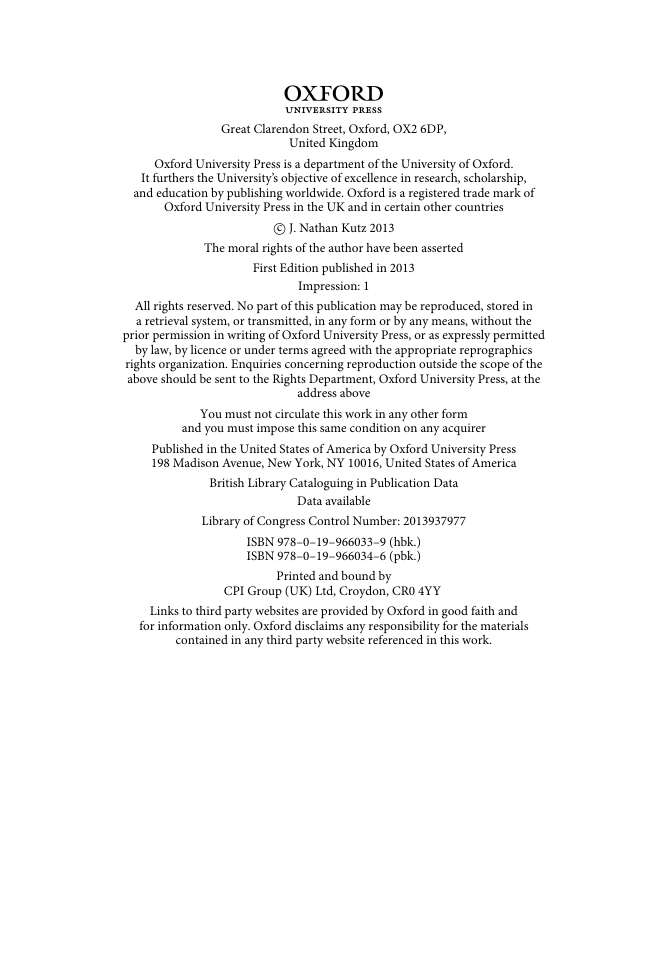Cover
Contents
Prolegomenon
How to Use This Book
About MATLAB
PART I: Basic Computations and Visualization
1 MATLAB Introduction
1.1 Vectors and Matrices
1.2 Logic, Loops and Iterations
1.3 Iteration: The Newton–Raphson Method
1.4 Function Calls, Input/Output Interactions and Debugging
1.5 Plotting and Importing/Exporting Data
2 Linear Systems
2.1 Direct Solution Methods for Ax = b
2.2 Iterative Solution Methods for Ax = b
2.3 Gradient (Steepest) Descent for Ax = b
2.4 Eigenvalues, Eigenvectors and Solvability
2.5 Eigenvalues and Eigenvectors for Face Recognition
2.6 Nonlinear Systems
3 Curve Fitting
3.1 Least-Square Fitting Methods
3.2 Polynomial Fits and Splines
3.3 Data Fitting with MATLAB
4 Numerical Differentiation and Integration
4.1 Numerical Differentiation
4.2 Numerical Integration
4.3 Implementation of Differentiation and Integration
5 Basic Optimization
5.1 Unconstrained Optimization (Derivative-Free Methods)
5.2 Unconstrained Optimization (Derivative Methods)
5.3 Linear Programming
5.4 Simplex Method
5.5 Genetic Algorithms
6 Visualization
6.1 Customizing Plots and Basic 2D Plotting
6.2 More 2D and 3D Plotting
6.3 Movies and Animations
PART II: Differential and Partial Differential Equations
7 Initial and Boundary Value Problems of Differential Equations
7.1 Initial Value Problems: Euler, Runge–Kutta and Adams Methods
7.2 Error Analysis for Time-Stepping Routines
7.3 Advanced Time-Stepping Algorithms
7.4 Boundary Value Problems: The Shooting Method
7.5 Implementation of Shooting and Convergence Studies
7.6 Boundary Value Problems: Direct Solve and Relaxation
7.7 Implementing MATLAB for Boundary Value Problems
7.8 Linear Operators and Computing Spectra
8 Finite Difference Methods
8.1 Finite Difference Discretization
8.2 Advanced Iterative Solution Methods for Ax = b
8.3 Fast Poisson Solvers: The Fourier Transform
8.4 Comparison of Solution Techniques for Ax = b: Rules of Thumb
8.5 Overcoming Computational Difficulties
9 Time and Space Stepping Schemes: Method of Lines
9.1 Basic Time-Stepping Schemes
9.2 Time-Stepping Schemes: Explicit and Implicit Methods
9.3 Stability Analysis
9.4 Comparison of Time-Stepping Schemes
9.5 Operator Splitting Techniques
9.6 Optimizing Computational Performance: Rules of Thumb
10 Spectral Methods
10.1 Fast Fourier Transforms and Cosine/Sine Transform
10.2 Chebychev Polynomials and Transform
10.3 Spectral Method Implementation
10.4 Pseudo-Spectral Techniques with Filtering
10.5 Boundary Conditions and the Chebychev Transform
10.6 Implementing the Chebychev Transform
10.7 Computing Spectra: The Floquet–Fourier–Hill Method
11 Finite Element Methods
11.1 Finite Element Basis
11.2 Discretizing with Finite Elements and Boundaries
11.3 MATLAB for Partial Differential Equations
11.4 MATLAB Partial Differential Equations Toolbox
PART III: Computational Methods for Data Analysis
12 Statistical Methods and Their Applications
12.1 Basic Probability Concepts
12.2 Random Variables and Statistical Concepts
12.3 Hypothesis Testing and Statistical Significance
13 Time–Frequency Analysis: Fourier Transforms and Wavelets
13.1 Basics of Fourier Series and the Fourier Transform
13.2 FFT Application: Radar Detection and Filtering
13.3 FFT Application: Radar Detection and Averaging
13.4 Time–Frequency Analysis: Windowed Fourier Transforms
13.5 Time–Frequency Analysis and Wavelets
13.6 Multi-Resolution Analysis and the Wavelet Basis
13.7 Spectrograms and the Gábor Transform in MATLAB
13.8 MATLAB Filter Design and Wavelet Toolboxes
14 Image Processing and Analysis
14.1 Basic Concepts and Analysis of Images
14.2 Linear Filtering for Image Denoising
14.3 Diffusion and Image Processing
15 Linear Algebra and Singular Value Decomposition
15.1 Basics of the Singular Value Decomposition (SVD)
15.2 The SVD in Broader Context
15.3 Introduction to Principal Component Analysis (PCA)
15.4 Principal Components, Diagonalization and SVD
15.5 Principal Components and Proper Orthogonal Modes
15.6 Robust PCA
16 Independent Component Analysis
16.1 The Concept of Independent Components
16.2 Image Separation Problem
16.3 Image Separation and MATLAB
17 Image Recognition: Basics of Machine Learning
17.1 Recognizing Dogs and Cats
17.2 The SVD and Linear Discrimination Analysis
17.3 Implementing Cat/Dog Recognition in MATLAB
18 Basics of Compressed Sensing
18.1 Beyond Least-Square Fitting: The L[sup(1)] Norm
18.2 Signal Reconstruction and Circumventing Nyquist
18.3 Data (Image) Reconstruction from Sparse Sampling
19 Dimensionality Reduction for Partial Differential Equations
19.1 Modal Expansion Techniques for PDEs
19.2 PDE Dynamics in the Right (Best) Basis
19.3 Global Normal Forms of Bifurcation Structures in PDEs
19.4 The POD Method and Symmetries/Invariances
19.5 POD Using Robust PCA
20 Dynamic Mode Decomposition
20.1 Theory of Dynamic Mode Decomposition (DMD)
20.2 Dynamics of DMD Versus POD
20.3 Applications of DMD
21 Data Assimilation Methods
21.1 Theory of Data Assimilation
21.2 Data Assimilation, Sampling and Kalman Filtering
21.3 Data Assimilation for the Lorenz Equation
22 Equation-Free Modeling
22.1 Multi-Scale Physics: An Equation-Free Approach
22.2 Lifting and Restricting in Equation-Free Computing
22.3 Equation-Free Space–Time Dynamics
23 Complex Dynamical Systems: Combining Dimensionality Reduction, Compressive Sensing and Machine Learning
23.1 Combining Data Methods for Complex Systems
23.2 Implementing a Dynamical Systems Library
23.3 Flow Around a Cylinder: A Prototypical Example
PART IV: Scientific Applications
24 Applications of Differential Equations and Boundary Value Problems
24.1 Neuroscience and the Hodgkin–Huxley Model
24.2 Celestial Mechanics and the Three-Body Problem
24.3 Atmospheric Motion and the Lorenz Equations
24.4 Quantum Mechanics
24.5 Electromagnetic Waveguides
25 Applications of Partial Differential Equations
25.1 The Wave Equation
25.2 Mode-Locked Lasers
25.3 Bose–Einstein Condensates
25.4 Advection–Diffusion and Atmospheric Dynamics
25.5 Introduction to Reaction–Diffusion Systems
25.6 Steady State Flow Over an Airfoil
26 Applications of Data Analysis
26.1 Analyzing Music Scores and the Gábor Transform
26.2 Image Denoising through Filtering and Diffusion
26.3 Oscillating Mass and Dimensionality Reduction
26.4 Music Genre Identification
References
Index of MATLAB Commands
A
B
C
D
E
F
G
H
I
L
M
N
O
P
Q
R
S
T
U
V
W
X
Y
Index
A
B
C
D
E
F
G
H
I
J
K
L
M
N
O
P
Q
R
S
T
U
V
W
















 2023年江西萍乡中考道德与法治真题及答案.doc
2023年江西萍乡中考道德与法治真题及答案.doc 2012年重庆南川中考生物真题及答案.doc
2012年重庆南川中考生物真题及答案.doc 2013年江西师范大学地理学综合及文艺理论基础考研真题.doc
2013年江西师范大学地理学综合及文艺理论基础考研真题.doc 2020年四川甘孜小升初语文真题及答案I卷.doc
2020年四川甘孜小升初语文真题及答案I卷.doc 2020年注册岩土工程师专业基础考试真题及答案.doc
2020年注册岩土工程师专业基础考试真题及答案.doc 2023-2024学年福建省厦门市九年级上学期数学月考试题及答案.doc
2023-2024学年福建省厦门市九年级上学期数学月考试题及答案.doc 2021-2022学年辽宁省沈阳市大东区九年级上学期语文期末试题及答案.doc
2021-2022学年辽宁省沈阳市大东区九年级上学期语文期末试题及答案.doc 2022-2023学年北京东城区初三第一学期物理期末试卷及答案.doc
2022-2023学年北京东城区初三第一学期物理期末试卷及答案.doc 2018上半年江西教师资格初中地理学科知识与教学能力真题及答案.doc
2018上半年江西教师资格初中地理学科知识与教学能力真题及答案.doc 2012年河北国家公务员申论考试真题及答案-省级.doc
2012年河北国家公务员申论考试真题及答案-省级.doc 2020-2021学年江苏省扬州市江都区邵樊片九年级上学期数学第一次质量检测试题及答案.doc
2020-2021学年江苏省扬州市江都区邵樊片九年级上学期数学第一次质量检测试题及答案.doc 2022下半年黑龙江教师资格证中学综合素质真题及答案.doc
2022下半年黑龙江教师资格证中学综合素质真题及答案.doc